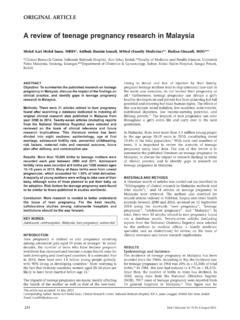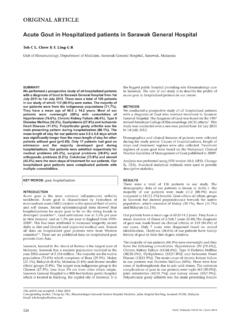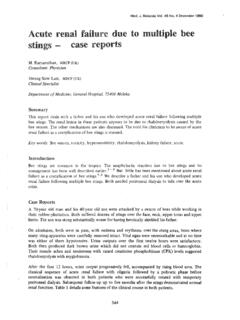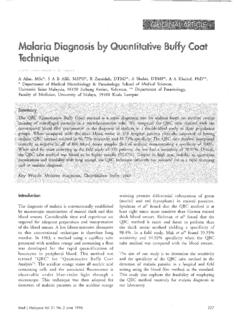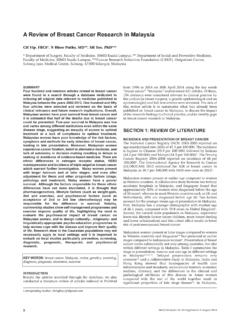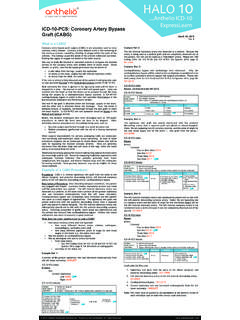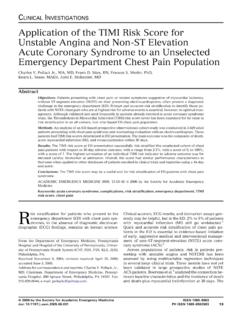Transcription of A Review of Coronary Artery Disease Research in Malaysia
1 A Review of Coronary Artery Disease Research in Malaysia Ang Choon Seong, MB ChB1, Chan Kok Meng John, FRCS CTh2,3. 1. Clinical Research Centre, Hospital Seberang Jaya, Pulau Pinang, Malaysia , 2 Department of Cardiothoracic Surgery, Sarawak Heart Centre, 94300 Kota Samarahan, Kuching, Sarawak, Malaysia , 3 National Heart and Lung Institute, Imperial College London, ABSTRACT. Coronary Artery Disease is the major cause of mortality and inflammation in atherogenesis has been recently morbidity in Malaysia and worldwide. This paper reviews all demonstrated. Tiong et al4 examined the role of early Research and publications on Coronary Artery Disease in inflammatory markers namely interleukin-6 (IL-6), von Malaysia published between 2000-2015. 508 papers were Willebrand Factor (vWF) and platelet activation marker, P- identified of which 146 papers were selected and reviewed selectin, in the early phases of acute Coronary syndrome on the basis of their relevance.
2 The epidemiology, etiology, (ACS). The authors measured serum levels of these markers in risk factors, prevention, assessment, treatment, and 22 ACS patients and 28 stable CAD controls. They found a outcomes of Coronary Artery Disease in the country are significant increase in serum levels of IL-6 and vWF in the reviewed and summarized. The clinical relevance of the ACS group compared to controls. This is consistent with studies done in the country are discussed along with studies showing a prominent role of inflammation and recommendations for future Research . endothelial dysfunction in the early phase of ACS. In another study, Tiong et demonstrated that serum and KEY WORDS: peripheral blood levels of CRP and vWF were significantly higher in ACS reflecting an acute phase response due to Acute Coronary syndrome, myocardial infarction, Coronary Disease , endothelial dysfunction in early the phase of ACS.
3 Coronary Artery Disease , ischaemic heart Disease EPIDEMIOLOGY. INTRODUCTION According to the World Health Organization, CAD accounted Coronary Artery Disease is the leading cause of mortality for deaths per 100,000 population in Malaysia in 2012, worldwide and in Amongst the more developed or 29,400 deaths ( of all deaths); it is the most common countries, the highest death rates from Coronary heart Disease cause of deaths in the The Malaysian burden of are in the Ukraine and Russian Federation with 718 and 654 Disease study6 conducted in 2000 found CAD to be the biggest deaths per 100,000 population respectively, while the lowest cause of death with a total of 22,158 deaths or about one fifth are in South Korea and Japan with and deaths per of all deaths. Much information on the burden of Disease has 100,000 Although much Research has been also been obtained from death certifications and hospital done on Coronary Artery Disease worldwide, it is important to admission records in Ministry of Health hospitals where Review the Research done in Malaysia to better understand circulatory Disease accounted for of total hospital the Disease in the country and how this impacts on clinical admissions and of all hospital deaths in 2014.
4 Practice locally. The National Cardiovascular Disease database (NCVD) is This paper reviews all papers published on Coronary Artery another important source of information on the Disease (CAD) Research done in Malaysia between 2000 and epidemiology of CAD in Malaysia . It provides useful data 2015. A literature search of all papers published on Coronary from 15 public hospitals, 1 university hospital and the Artery Disease in Malaysia was done as previously National Heart Institute. The acute Coronary syndrome (ACS). The PubMed search involved the following medical subject registry enrolls patients presenting with acute Coronary headings (MeSH): acute Coronary syndrome, myocardial syndrome, ST-elevation myocardial infarction (STEMI), non- infarction, Coronary Disease , and Coronary Artery Disease . 508 ST elevation myocardial infarction (NSTEMI), and unstable articles were found of which 146 were included in this Review angina (UA), prospectively, while the percutaneous Coronary based on their relevance.
5 Intervention (PCI) registry enrolls patients undergoing PCI in participatory sites. SECTION 1 Review OF THE LITERATURE Age ETIOLOGY. The NCVD-ACS registry showed that Malaysians are having ACS at a younger age compared to the developed countries, The etiology of Coronary Artery Disease involving with a mean age of between to years compared to atherosclerosis is well studied. A fundamental role for mean ages of between to 68 years in most developed Corresponding Author: 42 Med J Malaysia Vol 71 Supplement 1 June 2016. A Review of Coronary Artery Disease Research in Malaysia Muda and colleagues8 retrospectively reviewed the prevalence of ethnicity and conventional risk factors of medical records of 165 patients in Hospital Universiti Sains diabetes mellitus, hypertension and hyperlipidemia in 302. Malaysia with angiographically proven CAD from 2002 to patients who were admitted for CABG in their centre.
6 Indian 2004 and found 92 patients (55%) had premature CAD (men patients were associated with a combination of all three risk less than 55 years old and women less than 65 years). These factors while the Chinese and Malays were mostly associated cases are associated with a positive family history of heart with hypertension and hyperlipidaemia. Disease and low HDL levels. Dhanjal et compared the cardiovascular risk factors More recently, Zuhdi et looked into the NCVD-PCI registry profile of Asian patients admitted with myocardial infarction data between 2007 to 2009 and categorized the patients into in a hospital in Kuala Lumpur (42 patients) and in young (less than 45 years for men, and less than 55 years for Birmingham, , (28 patients), with Caucasion patients women) and old (45 years and older for men, and 55 years admitted with myocardial infarction in Birmingham (20.))
7 And older for women). There were 1,595 patients of which patients). The study found a higher prevalence of diabetes 16% were categorized into the young CAD group and were amongst Asians in both countries compared to Caucasions significantly associated with more active smoking and which may explain the higher prevalence of CAD in this obesity compared to the older group. The study also found a ethnic group regardless of locality. preponderance towards single vessel Disease in the young RISK FACTORS. CAD group with better clinical outcomes. Gender Much is known about the risk factors for Coronary Artery CAD generally affects men more than women. Lee et Disease and its prevalence amongst the population in studied the various aspects of gender differences in 10,554 Malaysia . According to the World Health Organization, PCI patients in the NCVD-PCI registry between 2007 to 2009.
8 Of adults in the country have raised blood glucose, Women on average were 5 years older than men at have raised blood pressure, are obese, and 43%. presentation and with higher prevalence of risk factors. The of adult males are Much information has also been in-hospital and six month mortality were also higher in obtained from the National Health and Morbidity Survey women. In another paper, Lu et looked into the (NHMS), a national household survey of Malaysians. The differences in gender in the NCVD-ACS registry from 2006 to NHMS is carried out at 4 yearly intervals (4th NHMS in 2011). 2010 and found that among 13,591 patients, were It is a population-based, cross-sectional epidemiological women and they had more risk factors, were unlikely to study using two stage stratified method of sampling. It undergo intervention, and had higher mortality.
9 Provides useful and valid data on the prevalence of risk factors for non-communicable diseases (NCD). In the NHMS. Idris et studied the NCVD-ACS registry patients between 201116, 18,231 adults aged 18 years and above were recruited. 2006 and 2008 specifically on woman of reproductive age. were found to be hypertensive, two thirds of whom The authors reported that out of 9,702 patients, were were newly diagnosed. The prevalence of diabetes was , females but only were at the reproductive age (from 20 with more than half of them newly diagnosed. had to less than 40 years of age) and was associated with Indian hypercholesterolemia (serum total cholesterol > mmol/L). ethnicity, diabetes mellitus and hypertension. Young female The high prevalence of Coronary Artery Disease risk factors patients commonly present with STEMI and have poorer hypertension, diabetes mellitus, dyslipidaemia, smoking and prognosis.
10 Obesity are also consistently reported in the NCVD database registry which publishes annual reports. The NCVD-ACS17. Murty et reviewed 5,579 autopsy reports done at annual reports consistently report more than 95% of patients University Malaya Medical Centre from 1996 to 2005 to study having at least one established cardiovascular risk factor on the prevalence of cardiac deaths in females and found 83 out admission for ACS. of 936 female deaths were due to cardiac causes. The three main causes reported in the study were advanced CAD Table I summarizes the studies on Coronary Artery Disease risk ( ), hypertensive heart Disease ( ) and Coronary factors prevalence in the country. Most of the studies were atherosclerosis ( ). The study reported that done in urban populations with specialist cardiology services. hypertension, diabetes and pre-menopausal age were the In a case-control study done by Suleiman and colleagues18 in most significantly associated factors.
